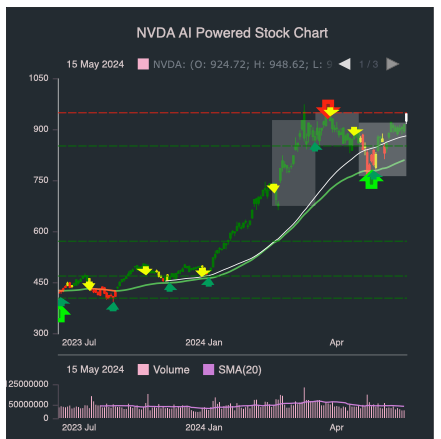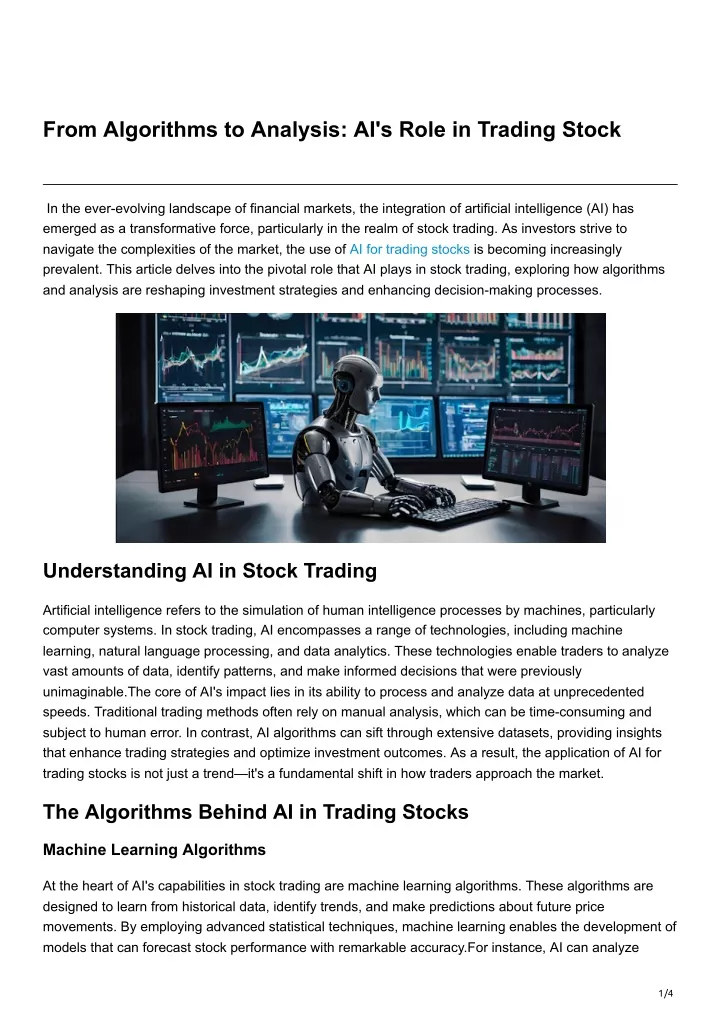20 Recommended Facts On Picking AI Stock Investing Analysis Sites
20 Recommended Facts On Picking AI Stock Investing Analysis Sites
Blog Article
Top 10 Tips To Evaluate The Ai And Machine Learning Models Of Ai Platform For Analyzing And Predicting Trading Stocks
The AI and machine (ML) model utilized by stock trading platforms and prediction platforms need to be evaluated to make sure that the information they offer are reliable, reliable, relevant, and useful. Overhyped or poorly designed models could result in inaccurate predictions and even financial loss. Here are 10 top ways to evaluate the AI/ML platform of these platforms.
1. Find out the intent and method of this model
Clarity of purpose: Determine if this model is intended to be used for trading on the short or long term, investment and sentiment analysis, risk management etc.
Algorithm transparency - Check to determine if there are any disclosures about the algorithm (e.g. decision trees neural nets, neural nets, reinforcement learning, etc.).
Customizability: Assess if the model can be customized to suit your particular investment strategy or risk tolerance.
2. Evaluation of Model Performance Metrics
Accuracy. Check out the model's ability to predict, but do not rely on it alone since this could be false.
Precision and recall (or accuracy) Assess how well your model can differentiate between genuine positives - e.g. accurate predictions of price fluctuations - as well as false positives.
Risk-adjusted results: Evaluate whether model predictions result in profitable trading despite accounting risk (e.g. Sharpe, Sortino and others.).
3. Test the model with Backtesting
Historical performance: Backtest the model using historical data to determine how it performed in past market conditions.
Check the model against information that it hasn't been trained on. This can help prevent overfitting.
Scenario analysis: Assess the model's performance in various market conditions.
4. Check for Overfitting
Overfitting: Look for models that are able to perform well using training data, but not so well with data that has not been observed.
Regularization Techniques: Examine to determine if your system uses techniques like dropout or L1/L2 regualization to prevent overfitting.
Cross-validation - Make sure that the platform utilizes cross-validation in order to assess the generalizability of your model.
5. Assess Feature Engineering
Relevant features: Ensure that the model is based on meaningful features (e.g. price or volume, as well as technical indicators).
Choose features carefully: The platform should only contain data that is statistically significant and not irrelevant or redundant ones.
Updates to features that are dynamic Check to see whether the model is able to adapt itself to the latest features or market changes.
6. Evaluate Model Explainability
Interpretability (clarity) Clarity (interpretation): Make sure to ensure that the model is able to explain its predictions clearly (e.g. importance of SHAP or the importance of features).
Black-box model Beware of applications that employ models that are too complicated (e.g. deep neural networks) without describing the methods.
The platform should provide user-friendly information: Make sure the platform offers actionable insights which are presented in a manner that traders can comprehend.
7. Examining Model Adaptability
Market fluctuations: See whether your model is able to adjust to market fluctuations (e.g. new regulations, economic shifts or black-swan events).
Continuous learning: Check if the platform updates the model often with fresh data to increase the performance.
Feedback loops: Make sure your platform incorporates feedback from users or real-world results to refine the model.
8. Check for Bias Fairness, Fairness and Unfairness
Data bias: Make sure that the data on training are representative of the market, and free of bias (e.g. overrepresentation in specific times or in certain sectors).
Model bias: Determine if the platform actively monitors the biases of the model's predictions and reduces them.
Fairness. Be sure that your model doesn't unfairly favor specific industries, stocks or trading strategies.
9. Calculate Computational Efficient
Speed: See if you can make predictions by using the model in real time.
Scalability: Check whether the platform can manage many users and huge data sets without affecting performance.
Resource usage: Determine whether the model is using computational resources efficiently.
Review Transparency, Accountability, and Other Issues
Documentation of the model. Ensure you have detailed documents of the model's structure.
Third-party validation: Find out whether the model has been independently verified or audited by an outside entity.
Check that the platform is equipped with a mechanism to identify model errors or failures.
Bonus Tips
User reviews and case studies Review feedback from users and case studies to evaluate the performance of the model in real-life situations.
Trial period: You can use the demo or trial version for free to evaluate the model's predictions as well as its the model's usability.
Support for customers: Make sure your platform has a robust support for problems with models or technical aspects.
If you follow these guidelines by following these tips, you will be able to evaluate the AI and ML models of stocks prediction platforms, making sure they are trustworthy and transparent. They should also be aligned to your goals in trading. Check out the most popular weblink on ai trading for more advice including chatgpt copyright, ai trade, ai investing app, stock ai, ai stock picker, ai trading, incite, ai trading, best ai trading software, ai trading and more.
Top 10 Tips To Assess The Latency And Speed Of Ai Stock Trading Platforms
Latency and speed are critical aspects to consider when looking at AI stock prediction and analysis platforms, specifically for algorithmic traders, active traders, and high-frequency traders. A delay of just milliseconds can be detrimental to the execution of trades. These are the top 10 tips for assessing the speed and latency of these platforms:
1. Data feeds in real-time to be evaluated
Data delivery speed - Ensure that the platform is able to provide real-time data with a minimum delay (e.g. an under-millisecond latency).
Nearness of the data source: To cut down the amount of time required to transfer data, make sure whether your server's servers are able to be found near exchanges that are major.
Data compression: Check if the platform is using efficient data compression to speed data delivery.
2. Test Rate for Trade Execution Rate
Processing orders: The platform's ability to execute and process trades quickly after an order is submitted.
Direct Market Access (DMA) Check to see if your platform supports DMA. This allows orders to be sent directly to the exchange without the need for intermediaries.
Execution reports: Find out whether the platform offers detailed execution reports, including timestamps for order submission, confirmation, and fill.
3. Review Platform Response
Speed of the user interface (UI) Test how fast the platform's user interface responds to your inputs.
Chart updates: Verify that charts and visuals are updated in real-time, without delay.
Mobile app performance. If you are using a mobile app that is running, it will perform as quickly as its desktop counterpart.
4. Look for infrastructure that is not low-latency.
Server locations: Make sure the platform uses low-latency servers located near major exchanges or financial hubs.
Co-location service: Discover whether your exchange offers this option. This allows you to host trading algorithm on servers located near the exchange.
High-speed networks - Verify that the platform is using fiber-optic high-speed networks or any other low-latency methods.
5. Evaluating Simulation and Backtesting speed
Find out how quickly the platform analyzes and processes the historical data.
Simulation latency: Verify that the platform can simulate trading in real time without obvious delays.
Parallel processing: Check that the platform is using parallel processing or distributed computing, which speeds up complex computations.
6. Assess API Latency
API responses: Determine how fast APIs respond to queries (e.g. retrieving data from the platform, placing orders).
Rate limits: Verify if the API has adequate rate limits to prevent delays in high-frequency trading.
WebSocket support: Check if the platform uses WebSocket protocols to support real-time, low-latency streaming of data.
7. Test Platform Stability When Loaded
High-volume trading Test the platform's flexibility and stability, try simulated high-volume scenarios.
Market volatility: Ensure that the platform can manage price fluctuations during periods that are high-risk.
Stress testing: Determine if your platform provides methods for stress testing strategies in extreme circumstances.
8. Evaluation of Network and Connectivity
Speed requirements for internet: Check that your internet connection has the platform's recommended speed to achieve the best performance.
Check for redundant connections.
VPN latency: When you use the VPN platform, verify whether the latency is high and if there are alternatives.
9. Check for Speed Optimization Features
Pre-trade analytics - Ensure that the platform is equipped with pre-trade analytical tools that can help optimize the routing of orders.
Smart order routing (SOR), also known as smart order routing, is a method to determine the fastest and the most cost effective execution venues.
Monitoring latency: Verify if the platform provides tools to monitor and analyze latency in real-time.
10. Review User Feedback and Benchmarks
User reviews: Review the feedback of users to evaluate the platform's performance in terms of speed and latency.
Third-party Benchmarks: Discover independent benchmarks to compare the speed of a platform with its rivals.
Case studies: Find out whether the platform offers testimonials or case studies highlighting the platform's low-latency capabilities.
Bonus Tips
Trial period: Use an unpaid trial or demo to evaluate the platform's performance and latency in actual scenarios.
Support for customers: Make sure the platform offers customer support to optimize latency or other issues.
Hardware specifications. Verify whether the platform is compatible with specific hardware like high-performance computers.
Following these tips can aid in assessing the performance of AI trading platforms that forecast or analyze price fluctuations in stocks. You will be able pick a trading platform which best suits the requirements of your trading and eliminates delays. The need for low latency is vital for algorithmic and high-frequency traders. Even minor delays can have a significant impact on profits. Check out the top my website ai copyright signals for site tips including chart ai trading, best ai stocks, trading ai tool, free ai stock picker, how to use ai for copyright trading, invest ai, best ai stocks, ai in stock market, stocks ai, best stock prediction website and more.